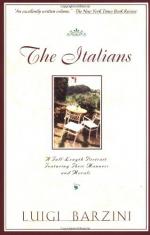* * * * *
San Frediano, a basilica in the Lombard style, is the most ancient church in Lucca. The mid-day sun now flashed full upon the front, and lighted up the wondrous colors of a mosaic on a gold ground, over the entrance. At one corner of the building a marble campanile, formed by successive tiers of delicate arcades, springs upward into the azure sky. Flocks of gray pigeons circled about the upper gallery (where hang the bells), or rested, cooing softly in the warm air, upon the sculptured cornice bordering the white arches. It was a quiet scene of tranquil beauty, significant of repose in life and of peace in death—the church, with its wide portals, offering an everlasting home to all who sought shelter within its walls.
The cavaliere was so impatient to do the honors that he actually jumped unaided from the carriage.
“This, dear Enrica, is my parish church,” he said, as he handed her out, pointing upward to the richly-tinted pile, which the suns of many centuries had dyed of a golden hue. “I know every stone in the building. From a child I have played in this piazza, under these venerable walls. My earliest prayers were said at the altar of the Sacrament within. Here I confessed my youthful sins. Here I received my first communion. Here I hope to lay my bones, when it shall please God to call me.”
Trenta spoke with a tranquil smile. It was clear neither life nor death had any terrors for him. “The very pigeons know me,” he added, placidly. He looked up to the campanile, gave a peculiar whistle, and, putting his hand into his pocket, threw down some grains of corn upon the pavement. The pigeons, whirling round in many circles (the sunlight flashing upon their burnished breasts, and upon the soft gray and purple feathers of their wings), gradually—in little groups of twos and threes—flew down, and finally settled themselves in a knot upon the pavement, to peck up the corn.
“Good, pious old man, how I honor you!” ejaculated Count Marescotti, fervently, as he watched the timid gray-coated pigeons gathering round the cavaliere’s feet, as he stood apart from the rest, serenely smiling as he fed them. “May thy placid spirit be unruffled in time and in eternity!”
The interior of the church, in the Longobardic style, is bare almost to plainness. On entering, the eye ranges through a long broad nave with rounded arches, the arches surmounted by narrow windows; these dividing arches, supported on single columns with monumental capitals, forming two dark and rather narrow aisles. The high altar is raised on three broad steps. Here burn a few lights, dimmed into solitary specks by the brightness of the sun. The walls on either side of the aisles are broken by various chapels. These lie in deep shadow. The roof, formed of open rafters, bearing marks of having once been elaborately gilded, is now but a mass of blackened timbers. The floor is of brick, save where oft-recurring sepulchral




